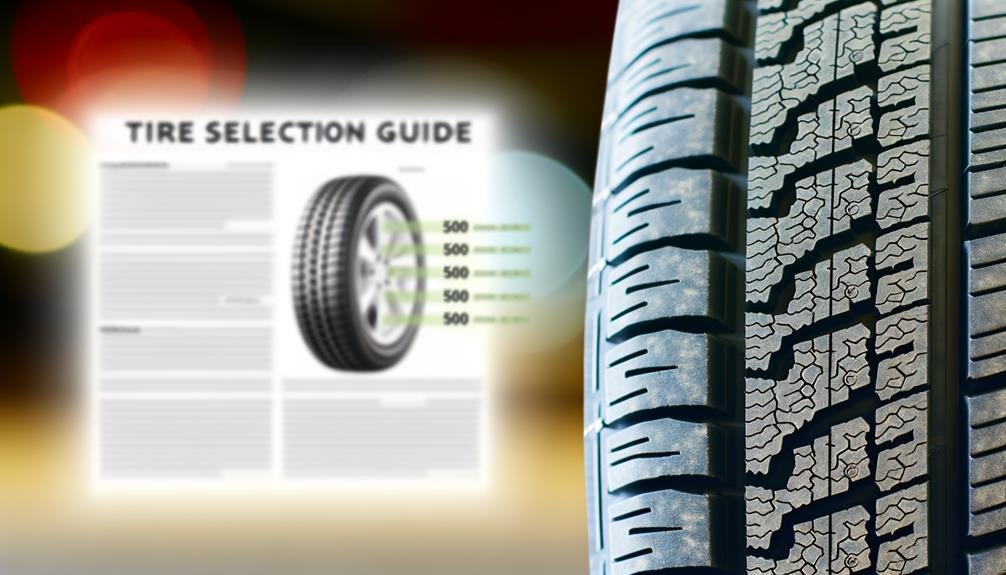Charles Miller is a veteran bike enthusiast with over 12 years of experience dealing with bikes as a mechanic. Despite immense love and expertise for...
In the realm of tire selection, treadwear ratings play a crucial role in determining the expected lifespan of a tire. One common question often posed by consumers and automobile enthusiasts alike is 'How many miles equates to a 500 treadwear rating?'
A treadwear rating of 500, while seemingly a concrete figure, is influenced by a plethora of factors, including driving conditions and maintenance practices, thus it does not directly translate to a set number of miles. This makes the task of converting treadwear ratings into mileage a complex issue worthy of a comprehensive exploration.
Join us as we unpack the intricacies of this topic, and strive to provide a clearer understanding of what a 500 treadwear rating truly represents in terms of mileage.
- Key Takeaways
- Understanding Treadwear Ratings
- Deciphering the 500 Treadwear Rating
- Factors Influencing Treadwear Performance
- Translating Treadwear Rating Into Miles
- Choosing Tires Based on Ratings
- Maximizing Lifespan of 500 Treadwear Tires
- Importance of Treadwear Rating in Tire Selection
- Frequently Asked Questions
- Conclusion
Key Takeaways
- Treadwear ratings are estimates of a tire's expected lifespan and provide an approximate mileage before the tire wears out.
- The 500 treadwear rating signifies an approximate tire lifespan of 50,000 miles, but actual mileage can vary based on driving habits, road conditions, and maintenance routines.
- Proper tire care, including regular rotation and alignment checks, can extend the tire life beyond the treadwear rating.
- Treadwear ratings should be considered alongside other performance factors, such as traction and temperature resistance, when selecting tires.
Understanding Treadwear Ratings
In the realm of tire longevity, treadwear ratings, such as the 500 treadwear rating, play a pivotal role, denoting an approximate mileage of 50,000 miles before the tire wears out. Understanding treadwear ratings is crucial in estimating the expected lifespan of a tire and planning subsequent replacements.
Primarily, a tire's treadwear rating is an estimate, not an exact measurement, and actual mileage can vary based on multiple factors. Tire treadwear ratings, often referred to as Uniform Tire Quality Grading (UTQG) treadwear ratings, provide a comparative tool for consumers. While a 500 treadwear rating indicates an estimated tire mileage of around 50,000 miles, the actual lifespan can be influenced by the driver's style, road conditions, and maintenance practices. Therefore, the tire life suggested by the treadwear rating should be seen as an approximation.
Regular maintenance, including proper inflation, alignment, and tire rotation, can significantly extend the tire life beyond the expected mileage. Concurrently, harsh driving habits or poor road conditions can shorten it. Hence, while treadwear ratings are a useful guide, they should not be the sole determiner of tire replacement.
Deciphering the 500 Treadwear Rating
Peeling back the layers of a 500 treadwear rating, one finds that it signifies an approximate tire lifespan of 50,000 miles, contingent upon various factors such as driving habits, road conditions, and maintenance routines. Deciphering the 500 treadwear rating is pivotal to understanding how many miles a tire is expected to last. This rating is part of the Uniform Tire Quality Grading (UTQG) system set by tire manufacturers, and is instrumental in predicting the mileage a tire might cover before needing replacement.
The UTQG treadwear rating is not an absolute measure and can vary due to individual driving habits and maintenance routines. Proper tire care, including regular rotation and alignment checks, can greatly extend the life of a tire, sometimes even beyond its treadwear rating.
| Factors | Impact |
|---|---|
| Driving Habits | Aggressive driving can reduce tire lifespan. |
| Road Conditions | Rough, uneven surfaces accelerate tire wear. |
| Maintenance | Proper care can extend tire life beyond the treadwear rating. |
Thus, the tire treadwear rating is a useful benchmark but should be considered alongside other individual usage factors for a comprehensive understanding of tire lifespan.
Factors Influencing Treadwear Performance

While the treadwear rating offers an estimation of tire longevity, it's crucial to understand the array of factors that can influence this performance, including driving style, road conditions, maintenance practices, and the tread compound itself. A 500 treadwear rating, for instance, doesn't guarantee a specific mileage but provides an estimate based on standard test conditions.
Aggressive driving styles, characterized by frequent braking and high-speed cornering, can result in accelerated tire wear. Road conditions also play a significant role. Potholed, gravel, or uneven surfaces can lead to uneven wear, shortening the actual lifespan of the tire.
Proper tire maintenance all play crucial roles in maximizing tire life. Optimal inflation, regular rotation, and alignment can mitigate uneven wear, effectively extending the tire's serviceable life.
The tread compound, determined by tire treadwear grades, also significantly affects tire longevity. Softer compounds provide better grip but wear faster, while harder compounds, often associated with higher treadwear ratings, last longer.
In essence, the treadwear rating indicates an estimated tire lifespan under ideal conditions. Understanding the factors influencing treadwear performance can help you gauge how many miles a 500 treadwear rating might realistically offer in your specific driving circumstances.
Translating Treadwear Rating Into Miles
Given the factors previously discussed, translating a 500 treadwear rating into actual miles requires a nuanced understanding of tire lifespans and the variables that can influence them. While a 500 treadwear rating is typically associated with approximately 50,000 miles, this is an estimation and the precise treadwear mileage depends on several factors such as driving habits, road conditions, and tire maintenance.
The tire mileage of a 500 treadwear rating could potentially reach up to 100,000 miles given ideal conditions and diligent upkeep. However, it is vital to remember that, despite the treadwear rating, tire durability and tire longevity can vary greatly.
Here is a table summarizing the main points:
| Treadwear Rating | Estimated Mileage |
|---|---|
| 500 | 50,000 miles |
| 500 (with good maintenance and ideal conditions) | 100,000 miles |
Choosing Tires Based on Ratings

When selecting tires, understanding treadwear ratings becomes crucial as it provides an estimate of the tire's durability. This rating, however, should be considered alongside other performance factors such as traction and temperature resistance.
A comprehensive evaluation of these parameters will ensure wise and informed tire selection, thereby promoting longevity and optimal performance.
Understanding Treadwear Ratings
The 500 treadwear rating, an estimation system established in the late 1970s, indicates that a tire should have the durability to last approximately 50,000 miles under optimal conditions and maintenance practices.
Understanding treadwear ratings can assist consumers in selecting the right tires based on expected tire mileage. The treadwear rating is an estimation of a tire's longevity. It provides an idea of how many miles a tire can cover before tire wear becomes apparent.
However, actual tread life is influenced by individual driving styles, road conditions, and tire maintenance practices. Proper tire maintenance can extend tire performance and longevity.
Generally, tires with a higher treadwear rating are expected to have a longer lifespan, offering more miles of travel before they need replacement.
Selecting Tires Wisely
In selecting tires wisely, it is crucial to consider not only the treadwear rating, but also other performance factors such as traction and temperature resistance, in addition to aligning the tire type with the specific driving needs and budget constraints.
A 500 treadwear rating typically signifies a tire's longevity, but it should not be the sole determinant in your tire purchase decision. You should also take into account the UTQG ratings which offer a comprehensive overview of a tire's performance.
It's important to compare different tire ratings to choose the right tires for your vehicle. Remember, rating systems like the tire treadwear rating are tools to aid your decision-making process, but personal experiences and conditions may vary.
Be thorough and meticulous in your research for a successful selection.
Maximizing Lifespan of 500 Treadwear Tires
Optimizing the lifespan of tires with a 500 treadwear rating hinges not only on the inherent durability of the tires, but also on factors such as driving habits, road conditions, and diligent maintenance practices. Understanding how many miles a tire with a 500 treadwear rating can last before needing replacement, typically around 50,000 miles, is key to maximizing tire longevity.
Driving style significantly impacts tire wear. Aggressive driving, including fast acceleration and braking, can reduce the tire lifespan. Smooth, controlled driving extends the miles before needing replacement.
Road conditions also affect tire wear. Frequent driving on rough, uneven surfaces can expedite wear, shortening the lifespan of a 500 treadwear rating tire. Conversely, driving predominantly on well-maintained roads can increase tire longevity.
Tire maintenance is paramount to maximizing lifespan. Regularly checking and maintaining proper tire inflation, ensuring alignment, and performing tire rotation can significantly extend the life of tires with a 500 treadwear rating.
Importance of Treadwear Rating in Tire Selection

Building on the understanding of how to maximize the lifespan of a 500 treadwear tire, it is essential to delve into the significance of the treadwear rating itself in the context of tire selection. The treadwear rating is a critical aspect in the tire industry, particularly for vehicle owners seeking to balance cost, performance, and safety in passenger vehicles.
The importance of treadwear rating in tire selection can be elucidated as follows:
- It provides an estimate of tire durability and longevity:
- A 500 treadwear rating suggests a tire may last approximately 50,000 miles, though actual mileage can vary significantly.
- Higher ratings usually indicate longer-lasting tires, offering better value for money.
- It informs maintenance practices and safety considerations:
- Tread patterns, influenced by treadwear, affect traction and vehicle handling.
- Regular tire maintenance can extend the lifespan of a tire, irrespective of its treadwear rating.
Frequently Asked Questions
What Does a Treadwear Rating of 500 Mean?
A 500 treadwear rating signifies tire durability, indicating an expected lifespan of approximately 50,000 to 100,000 miles. Factors impacting this include driving habits, maintenance, climate, and road conditions, affecting safety, performance variations, and cost efficiency.
How Many Miles Is a 600 Treadwear Rating?
A 600 treadwear rating signifies an estimated longevity of approximately 60,000 miles. However, this can vary based on factors such as driving habits, tire maintenance, road conditions, and climate effects.
How Many Miles Is a 520 Treadwear Rating?
A 520 treadwear rating suggests superior tire longevity, approximately 52,000 miles. However, performance comparison, durability factors, weather impacts, road conditions, and maintenance importance can influence this. Manufacturer differences, tire rotation, inflation effects, and driving habits also matter.
How Many Miles Will a 400 Treadwear Last?
A 400 treadwear rating suggests tire longevity of approximately 40,000 miles. However, performance variation may occur due to road conditions, wear indicators, manufacturer's influence, tire maintenance, driving habits, treadwear grades, tire rotation, and climate impact.
Conclusion
In the realm of tire longevity, the 500 treadwear rating, which ostensibly corresponds to approximately 50,000 miles, is a key reference. Yet, this figure can be misleading. Factors such as driving habits, road conditions, and maintenance practices play substantial roles.
The ironic truth? A high treadwear rating doesn't guarantee a long-lasting tire. So, while treadwear ratings offer a benchmark, it's crucial to factor in other considerations when selecting tires to ensure optimal performance and longevity.

Charles Miller is a veteran bike enthusiast with over 12 years of experience dealing with bikes as a mechanic. Despite immense love and expertise for his Tacoma, he rides his Trek Ebike more. Anytime you meet him, you’ll either hear him talking about Bikes, or writing about all things bikes and cars on this blog.
More Posts


